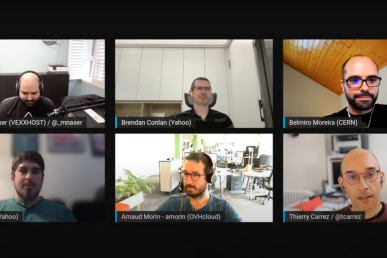Nike more or less stumbled into OpenStack.
“We didn’t start out trying to build a private cloud or even necessarily say, ‘Hey, we want OpenStack,’” said Peter Bogdanovic, lead architect, tech ops infrastructure at Nike. “We started out with the idea of changing the relationship with managed service providers…We basically wanted to manage our own V-center and V-infrastructure and the dev-ops teams wanted APIs. When we looked at the ways to deliver the APIs to them, we landed on OpenStack as the way that was most obvious.”
Bogdanovic shared his experience on a panel that included Wells Fargo and Adobe discussing OpenStack on VMware in production environments at the OpenStack Summit Vancouver. You can check out the entire 40-minute session online.
Talking about the workloads Nike is running on OpenStack, Bogdanovic said the data center is serving the legacy apps. One of the requirements Nike had when wresting more control over the v-sphere infrastructure is that they didn’t want to require any application changes, a requirement that ultimately made them more like pets than cattle, “unfortunately,” he added.
Bogdanovic says that the goal now is to but we’re trying to do to treat it more like cattle and “at least bring some automation to the deployment of these things” to make them shorter-lived. His main “consumer” for OpenStack is the release management group because they own the process that the application packages are deployed with to as they move to production.
The transition to OpenStack involved straddling a few hurdles.
“It was hard when it was managed service, everything would be a ticket,” he said. “There was a lot of resistance over giving up a VM because it took so long to get one created.” They’re currently using Heat paired with the Fog library and although they’ve only been using OpenStack for a short time, Nike is looking to make it a marathon and not a sprint. “We’re really discouraging anybody from using the GUI for anything or even the command line tools…Everything should be checked in. Any change that we make to the infrastructure anywhere should be should be documented with code and checked into source code management.”
Bogdanovic said that because the company relied so much on managed service providers that bringing those services in-house means measuring up to those same high standards. Teams at Nike are currently focusing on building out server monitoring capabilities and instant response capabilities.
“I want [these teams] to be very successful,” he said. “I don’t want my phone to ring all the time, but that’s something that still has to be proven in our organization.”
A core ops team of just five people is building it. “We’re going to building mass and then plug into an organization that’s bigger – teams that support the retail stores, etc. There’s there’s a bigger organization out there that we plug this into, and then you’re dealing with dozens of people or teams larger than that.”
When asked how he would do it differently in hindsight, Bogdanovic said a “customer-centric” approach would’ve helped speed things along.
“We went at it backwards…We should’ve said, ‘What do our customers want?’ They want these APIs to provision infrastructure and how are we going to provide that?’" That mistake was partly driven by what he termed an “aggressive” stance from the management team above, and could have been tempered by taking more time, he said.
“There was a lot of pressure to just go do it, just get something done.”
Cover Photo by Photon // CC BY NC
- OpenStack Homebrew Club: Meet the sausage cloud - July 31, 2019
- Building a virtuous circle with open infrastructure: Inclusive, global, adaptable - July 30, 2019
- Using Istio’s Mixer for network request caching: What’s next - July 22, 2019

)










